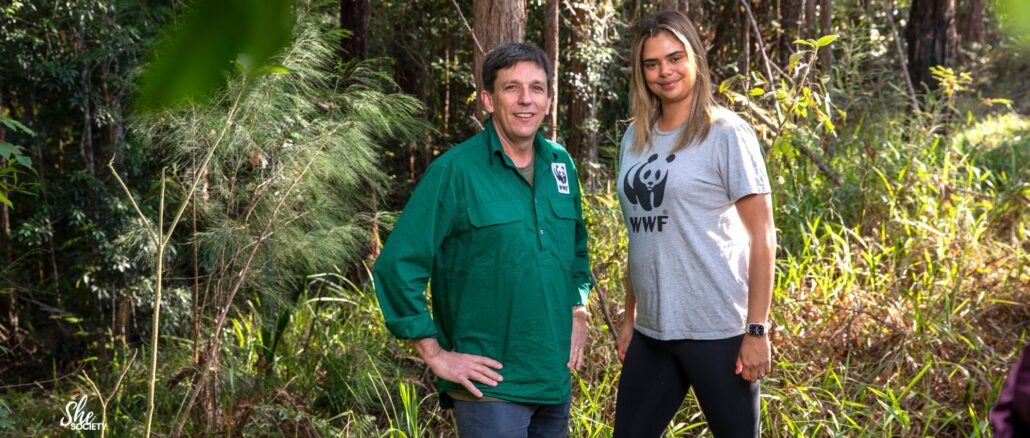
The World Wide Fund for Nature-Australia has released Australia’s first national scorecard to assess which states and territories are leading the way in protecting and restoring trees.
New South Wales and Queensland rated ‘Very Poor’ in the scorecard, compiled by WWF scientists, securing a position as Australia’s worst clearers of trees.
Australia has the highest rate of deforestation in the developed world and the scorecard assesses how all jurisdictions – state, territory, and federal – are performing in forest protection and restoration.
No state ranked higher than average, prompting WWF-Australia to call for strong leadership to halt and reverse forest loss.
South Australia tops WWF’s new Trees Scorecard; Logging (such as this operation in Lower Bucca State Forest) helped put NSW last
New South Wales came last with a score of only 24%. More than 264,000 hectares of land clearing occurred from FY18 to FY21. The equivalent of more than 180 football fields bulldozed per day. In the same period, loggers felled enough native forest trees to fill over 1000 Olympic-sized swimming pools (2,950,698 cubic meters).
Commitments by the new state government to protect koala habitat, once enacted, will improve NSW’s percentage total. To significantly boost its score, NSW should pledge to phase out native forest logging by 2024, and follow the lead of states such as Western Australia and Victoria in recent years.
Queensland came second last with a score of 32%. It has the nation’s highest rates of land clearing – 799,668 hectares were cleared from FY18 to FY21. That’s one tree bulldozed every second. To improve its score, Queensland needs to reduce land clearing by strengthening weak regulations and improving incentives for farmers to keep trees in the ground, with investment to stimulate deforestation free beef production desperately needed.
An example of the ongoing clearing pushing Qld to second last. Between Oct 2022 and Feb 2023, a cattle pasture developer, cleared 40 hectares, about 40 football fields, of koala habitat near Esk Qld. The area cleared is exempt from state tree protection laws.
The Federal government placed midway on the leaderboard with a score of ‘Poor’ because its strong commitments to halt and reverse deforestation are yet to be implemented.
“Although some states have made progress, New South Wales and Queensland are dragging the nation down. It’s time we protect the trees we have left and restore the ones we have lost because we all need trees, now more than ever as we face a warming climate,” said Dr Stuart Blanch, Senior Manager, Towards Two Billion Trees, WWF-Australia.
Fortunately, a story of hope can be sourced from the very state that has landed as the worst offender across the recent scorecard analysis, with a case study that if scaled up, could turn the trees score around for NSW.
Bangalow Koalas has shown what restoring trees can achieve with an amazing transformation, turning a bare paddock into koala habitat in just two years.
This paddock in Bangalow was bare until trees were planted on 31 August 2019; now it is a young forest and serves as a koala corridor
Planted on 31 August 2019, just 18 months later koalas were trying to feed on the young eucalypts. By October 2021, sensor camera recordings confirmed the trees were big enough to support the weight of feeding koalas. Now some trees are up to 10 metres high.
“Some people say it will take decades for wildlife to benefit from plantings. That is bollocks. Within two years koalas were feeding on these trees. They’ve formed part of a corridor helping koalas disperse west. So plant now. Koalas don’t have the liberty of time. No trees, no life and no hope,” said Bangalow Koalas President Linda Sparrow.
Property owner and local artist Hilary Herrmann said the trees are about leaving a legacy.
“With so much loss of habitat, there’s no place for animals to live anymore. We need to put something back. Not just for the animals but also for ourselves, especially for the children coming through behind us. Trees can provide the awe and splendour we need in our lives to make us feel ok,” Ms Herrmann said.
Koalas are among the native animals that can benefit from plantings in just a few years. However, more than 300 Australian species — mammals, birds, reptiles and amphibians — use tree hollows which only appear in mature trees.
In fact, species such as greater gliders require large hollows that can take up to 250 years to form. Protecting these old forests is crucial to stop Australia’s extinction crisis.
Greater gliders require hollows that can take up to 250 years to form.
“We believe Australia can become a nation that not only protects and preserves its trees, but also leads the way in sustainable certified timber plantations and conservation,” said Dr Blanch
“Our plan is to take Australia from a deforestation hotspot to a leader in tree protection and restoration for the benefit of our health, communities, businesses, economy, wildlife, our climate and planet,” he said.
We all need trees. Add your voice to save our trees to save our future at: wwf.org.au/we-all-need-trees.
SheSociety is a site for the women of Australia to share our stories, our experiences, shared learnings and opportunities to connect.

Leave a Reply